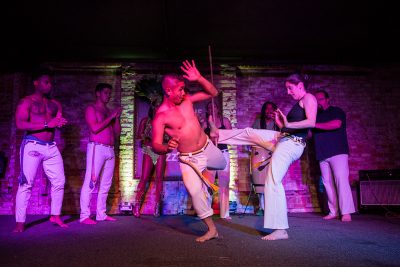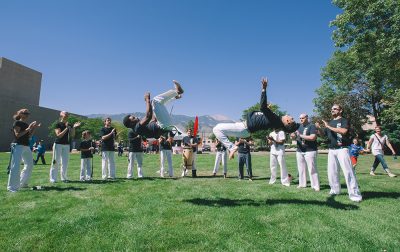On a Thursday afternoon, students at Springs Dance studio on Centennial Boulevard warm up in a sunlit, two-story practice studio lined with mirrors and musical instruments. In the hall, parents chat quietly or peek proudly through the open door. It’s a familiar scene for a local dance studio, but what these students are learning is truly unique in the Pikes Peak region.
In fact, these are not dancers but capoeiristas (cop-wear-ee-stas), learning a Brazilian performing art that combines the physical discipline of martial arts with lively drumming, acrobatics, samba, stick dance and more.
Founders Mago and Anne Lauritzen moved here in 2003, specifically to launch a school for Brazilian capoeira in Colorado Springs. When choosing the Pikes Peak region, the couple noted our high rankings for physical fitness, growing economy and local enthusiasm for more diverse cultural offerings. Even more specifically, as your Woodmen-area neighbors, they “love this part of town. We love walking out the front door and seeing Pikes Peak.”
Over the past 14 years, an impressively positive, confident and motivated community of Brazilian cultural practice has formed around the couple.
“I think what captivates me is the joy,” Anne said. “Brazilians are some of the most energetic, joyful people I have ever known.”

Visiting their studio, you feel the colorful energy that distinguishes Brazilian capoeira from the inward, meditative seriousness of the Asian martial arts. Practitioners here learn to play multiple instruments, sing and speak in Portuguese and perform their acrobatic, ritualized fight sequences with a spirit of clever play and teasing. Even Mago’s teaching style is playful. Experience a few minutes of his charmingly funny instruction and meet Anne by watching the studio visit I broadcast live on Facebook at tinyurl.com/zxu5cmx.
Capoeiristas call this “malacia,” a subversive trickery woven into the tradition by the 16th century Angolan slaves who developed capoeira for self defense and entertainment. Capoeira celebrates artful evasion more than a headlong attack.
“As capoeiristas, we practice creative problem solving,” Anne said. “How can I creatively deal with the adversity I’ve been given? It’s beautiful the way that’s built into the movement of capoeira.”
It is beautiful to watch Brazilian capoeira. It’s also inspiring how this local community of capoeiristas explores positive responses to adversity and challenge, together. That’s an art form all its own, and one that we all need, no matter our age.

The class I observed was a family class, with students of different generations developing their strength and skills side by side. Parents and children can learn to spar, drum. tumble and sing together as equals within this tradition, because capoeira’s techniques dismantle physical differences in strength and size. That equity and community is reflected in the traditional capoeira circle formation, the “roda” (hoda).
You can join the circle, too, by visiting Brazilian capoeira at Springs Dance studio or seeing them perform at a variety of local festivals and events across the region this year.
“Our motivation is to use our bodies in powerful new ways,” Anne said. But after meeting her, Mago, and their community of capoeiristas, it’s clear that our local capoeira community uses the collective leverage of their hearts and minds in powerful new ways, too.
Originally written by Angela Seals of the Cultural Office and published in the Woodmen Edition on March 1, 2017.